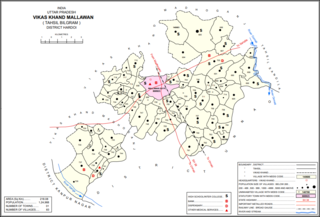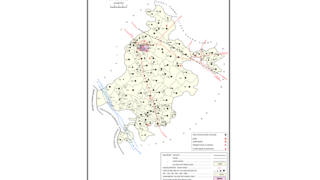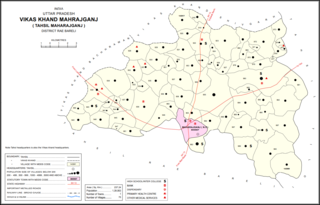
Unnao district is a district of Uttar Pradesh state in northern India. The city of Unnao is the district headquarters. The district is part of Lucknow Division.

Dalmau is a historic town and tehsil headquarters in Rae Bareli district of Uttar Pradesh, India. Situated on the banks of the Ganga, between Raebareli and Fatehpur, the town has several historical monuments including the old fort, several dargahs, and the Haji Zahid mosque. Dalmau is also home to the Ebrahim Sharki palace belonging to the Nawab Shuza-ud-daula. Visitors can also see the Baithak of Alha Udal and enjoy a stroll along the Dalmau Pump canal. Dalmau also enjoys a unique place in the literary world because it was here that the famous Hindi poet Suryakant Tripathi "Nirala" wrote his poems while sitting on the fort and overlooking the scene below.

Mallawan, also spelled Mallanwan is a town and Nagar Palika Parishad in Hardoi district of Uttar Pradesh, India. It served as the original district headquarters from 1856 to 1858. It is located south of Bilgram, on the road to Unnao. Mallawan is a major centre of handloom weaving, with handloom cloth being a major export. As of 2011, the population of Mallawan is 36,915, in 6,086 households. It is included in the legislative assembly constituency of Bilgram-Mallanwan.

Purwa is a town and nagar panchayat in Unnao district, Uttar Pradesh, India. It is located 32 km southeast of Unnao, the district headquarters. Roads connect it with several major cities including Unnao, Lucknow, Kanpur, and Rae Bareli. As of 2011, its population is 24,467 people, in 4,128 households.
Ugu is a town and a nagar panchayat in Unnao district in the Indian state of Uttar Pradesh. First officially classified as a town for the 1981 census, Ugu is an old town with medieval ruins that hosts a biweekly market and an annual mela. It is located on the main Unnao-Hardoi road, a bit northwest of Safipur. Some of the main items manufactured here are shoes, slippers, furniture, and lipstick cover. As of 2011, the population is 6,318, in 1,044 households.

Baksar is a village in Sumerpur block of Unnao district, Uttar Pradesh, India. The southernmost village in the district, Baksar is located on the bank of the Ganges at a spot where it flows slightly northward. Because of this, the river is considered especially sacred here, and enormous crowds gather here to bathe in its waters at a mela during the month of Kartik. The spot has a temple dedicated to Sri Chandrika Devi on the riverbank. As of 2011, the population of Baksar is 2,413 people, in 466 households.

Magrayar is a village in Bighapur block of Unnao district, Uttar Pradesh, India. Located 7km from Bighapur, Magrayar hosts a market on Mondays and Thursdays and was historically the seat of a pargana since at least the late 1500s. As of 2011, Magrayar's population is 4,248, in 964 households.

Miyanganj, also spelled Mianganj, is a village and corresponding community development block in Hasanganj tehsil of Unnao district, Uttar Pradesh, India. It is located on the road from Lucknow to Bangarmau, just to the west of the crossroads with another route linking Unnao and Sandila.

Jhalotar is a village in Hasanganj block of Unnao district, Uttar Pradesh, India. It is located just to the west of the Mohan-Ajgain road, near a lake called Kundra Samundar. It hosts a weekly haat and has one primary school and no healthcare facilities. Drinking water is provided by hand pump. As of 2011, the population of the village is 1,990, in 319 households.

Kantha is a village in Asoha block of Unnao district, Uttar Pradesh, India. It hosts two small melas, one of which is the Mahabirji-ka-Mela, held every Tuesday during the month of Jyaistha. People bring sweets, toys, and other items to sell at the fair. Kantha also hosts a market twice per week, on Mondays and Fridays, with vegetables being the main item of trade. As of 2011, the population of Kantha is 9,973, in 2,079 households.

Sarwan is a village in Asoha block of Unnao district, Uttar Pradesh, India. It hosts a Deviji mela on Chaitra Badi 8-9 dedicated to the worship of the goddess Devi. Vendors bring agricultural implements, furniture, sweets, toys, and miscellaneous everyday items to sell at the fair. On Chait Krishna 7-8, Sarwan also hosts a market for the Durgaji Ka Mela, where mostly cloths and sweets are sold. Sarwan is located on a major district road and has one primary school and one medical practitioner. As of 2011, its population is 3,824, in 806 households.

Hilauli is a village in Purwa tehsil of Unnao district, Uttar Pradesh, India. It is located on the road from Maurawan to Bachhrawan in Rae Bareli district, near the banks of the Sai. Hilauli hosts a market twice per week, on sunday and Thursdays, with grain and vegetables being the main items bought and sold. As of 2011, the population of Hilauli is 13,318, in 2,533 households.

Mawai is a village in Hilauli block of Unnao district, Uttar Pradesh, India. As of 2011, its population is 14,690, in 2,734 households, and it has 8 primary schools and one medical clinic. It hosts a regular market and has a post office.

Panhan, also called Panhan Khas, is a small village in Purwa block of Unnao district, Uttar Pradesh, India. Located due south of Purwa and a bit to the west of the Loni River, it historically was the seat of a pargana. As of 2011, the village's population is 545 people, in 104 households.

Sumerpur is a hamlet of the village Chhanchhi Rai Khera, in Purwa tehsil of Unnao district, Uttar Pradesh, India. Located 26km south of Purwa and 50km southeast of Unnao, Sumerpur serves as the headquarters of a community development block as well as a nyaya panchayat. Sumerpur block was first established on 2 October 1955 in order to oversee implementation of India's Five-Year Plans at a local and rural level. As of 2011, the block comprises 148 villages and has a total population of 151,933 people in 28,469 households.

Bihar is a village in Sumerpur block of Unnao district, Uttar Pradesh, India. Located on the main Unnao-Raebareli road, just to the east of the Loni river and near its confluence with the Kharahi, Bihar was briefly the headquarters of a tehsil in Raebareli district from 1860 until 1862, when it was moved into Unnao district. As of 2011, the population of Bihar is 5,952, in 1,088 households, and it has 5 primary schools and no healthcare facilities.

Parsanda is a village in Bighapur block of Unnao district, Uttar Pradesh, India. It hosts a market on Thursdays, Fridays, and Sundays, and vegetables and cloth are the main items bought and sold. As of 2011, the population of Parsanda is 1,715, in 377 households, and it has one primary school and no healthcare facilities.

Thulendi is a village in Bachhrawan block of Rae Bareli district, Uttar Pradesh, India. It is located 6 km from Bachhrawan, the block headquarters, on an elevated plain with clayey soil. A historic village, Thulendi served as a pargana headquarters from the early 1400s until the late 1700s, and it has several old monuments including a fort built under the Jaunpur Sultanate and two large tanks othat are said to be even older. As of 2011, Thulendi's population is 6,616, in 1,195 households.

Hardoi is a village in Maharajganj block of Rae Bareli district, Uttar Pradesh, India. Located on the road from Maharajganj to Bachhrawan, Hardoi historically served as the seat of a pargana and has a now-ruined fort built in the early 1400s under the Jaunpur Sultanate. As of 2011, its population is 2,308, in 415 households.

Didaur, also spelled Dedaur, is a village in Sataon block of Rae Bareli district, Uttar Pradesh, India. It is located 8 km from Raebareli on the road to Unnao, just east of the intersection with the road to Lalganj. It is near the right bank of the Sai river. As of 2011, Didaur has a population of 4,781 people, in 900 households. The village hosts two annual festivals: one is the Badhwapur-ka-Mela, which is dedicated to the worship of Nag Devta and is held on Bhadra Sudi 5, and the other is the Jhurhapur-ka-Mela, which is dedicated to worship of Rama and falls on Phalguna Sudi 8.














